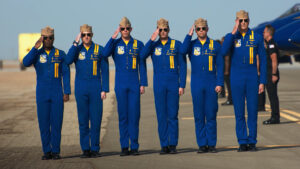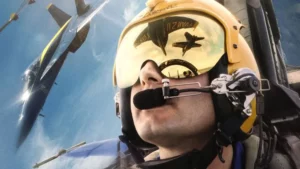Publication Date: 05-30-2024
The Blue Angels (2024) review
Dir. Paul Crowder
By: Steve Pulaski
Rating: ★★½
The Blue Angels is the latest showcase of rapidly advancing IMAX technology. It was shot with Sony’s Venice 2 IMAX-certified digital cameras, and features IMAX-exclusive Expanded Aspect Ratio (EAR) throughout its entire 93-minute runtime. As the title suggests, it follows the aerobatic team of Navy pilots who perform at least 60 shows across 30 cities in America. The documentary shows what it takes to dazzle a crowd and master some of the most difficult flight skills a pilot can possess.
The doc is produced by Glen Powell, who got to fly with the Blue Angels to prepare to film for his work in Top Gun: Maverick, along with J. J. Abrams. Split up into what amounts to three different acts, the first examines the daunting amount of training and practicing the six Angels (five Navy, one Marine Corps) and the remaining 152 active duty Sailors and Marines undergo in order to be able to achieve such performative feats. The midsection looks at several Angels selecting their replacements, who will don the uniform upon their retirement. The back-half follows the newbie pilots’ inauguration process and ensuing ceremony.

What you come for is the flying itself, which is masterfully filmed. You might wonder how director Paul Crowder and his team were able to squeeze gigantic IMAX cameras into the snug cockpits of the jets the Angels fly. Spoiler: the cameras were operated from a helicopter that followed the planes during training. The Angels themselves operate as a team, with their familial partnership hopefully advancing to the point that they can fly in “diamond formation,” with the gold ends of their jets’ wings approximately a foot from each other; so close that one false move or unwise action can cause a major catastrophe. The aforementioned filming technique is probably why we don’t see the jets perform a “scissors-cross” from the perspective of the pilots. You couldn’t fit an IMAX camera between the two jets in that instance.
Crowder, also one of three editors on the film, tries mightily to find a narrative through-line by showing what life is like for these Angels on the ground. Mostly, though, he focuses on the Commanding Office and Flight Leader Captain Brian Kesselring (aka “Boss”), who is also one of the three to leave the Angels by the end of the doc. Every day, he walks past a photo of the 27 former Angels, who died mid-flight. Seeing that every day, among many others, is why “you should never feel too comfortable in the suit,” he tells the audience.

Being that the Angels operate as a team, and their mission, as outlined on the Navy website, is “to showcase the teamwork and professionalism of the United States Navy and Marine Corps through flight demonstrations and community outreach while inspiring a culture of excellence and service to country,” we don’t learn much about these pilots as individuals. There’s a brief illustration of Kesselring’s home-life, which he gets to enjoy maybe two months out of the year with the other 300-some-odd days on the road. The film doesn’t draw attention to how unhappy his wife looks at times, probably because the Navy wouldn’t want to suggest that in order to live the life of a Blue Angel, all likely isn’t quiet for these pilots on the home-front.
During the third act, the Blue Angels’ first-ever female pilot, Amanda Lee, is inducted. While Kesselring says it’s important that her identity isn’t relegated simply to being “the first-ever…,” there’s not much effort made to distinguish her from the group. Much like the military itself, the humanization of the Angels is minimized for the greater good of showing what can be accomplished with teamwork and an unbridled commitment to detail. The Blue Angels is an enjoyable documentary, especially on the big screen, underscored by some incredible visuals and camerawork. But like one of the Angels’ gravity-defying aerial shows, this doc is part spectacle and part recruiting tool.
NOTE: The Blue Angels is now playing in theaters and available to stream on Amazon Prime Video.
Directed by: Paul Crowder.
About Steve Pulaski
Steve Pulaski has been reviewing movies since 2009 for a barrage of different outlets. He graduated North Central College in 2018 and currently works as an on-air radio personality. He also hosts a weekly movie podcast called "Sleepless with Steve," dedicated to film and the film industry, on his YouTube channel. In addition to writing, he's a die-hard Chicago Bears fan and has two cats, appropriately named Siskel and Ebert!


